Cultural Anthropology: A Deep Dive into the Potlatch Tradition Essay
VerifiedAdded on 2023/04/25
|6
|1174
|444
Essay
AI Summary
This essay explores the Potlatch, a gift-giving festival central to the cultures of the Pacific Northwest Coast. It delves into the festival's themes of songs, rituals, dance, and ceremony, highlighting the use of ceremonial masks and symbolic performances. The essay discusses the history of the Potlatch, its association with births, deaths, weddings, and other important events, and its complex social structure, which includes aristocrats, commoners, and slaves. It further examines the diverse practices of different clans, such as the Tlingit and Kwakiutl, and the reasons for the ban imposed on the tradition by the Canadian and American governments. The essay also includes an annotated bibliography of relevant sources that provide historical context, explore the conflicts and bans associated with the tradition, and analyze the symbolic immortality and political significance of the Potlatch.
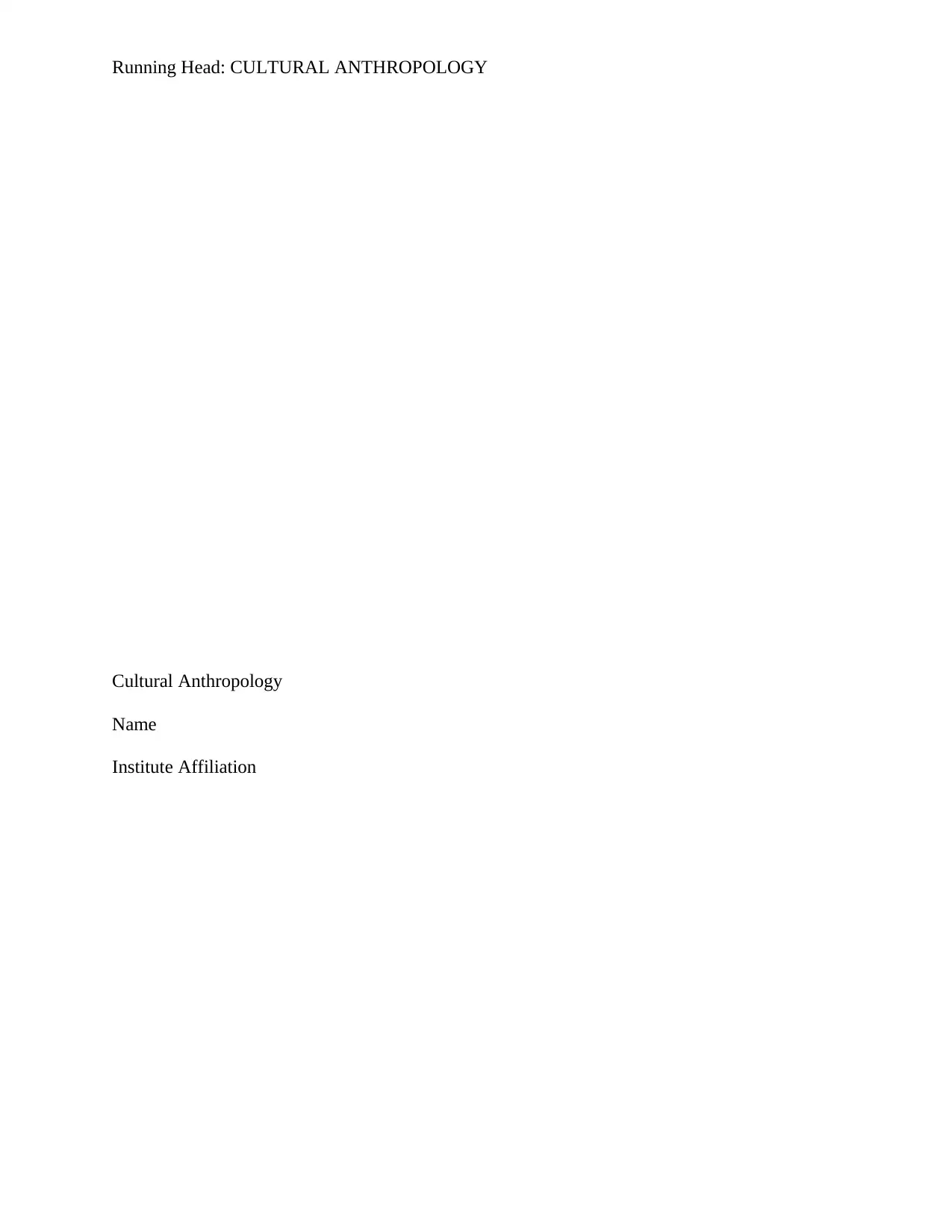
Running Head: CULTURAL ANTHROPOLOGY
Cultural Anthropology
Name
Institute Affiliation
Cultural Anthropology
Name
Institute Affiliation
Paraphrase This Document
Need a fresh take? Get an instant paraphrase of this document with our AI Paraphraser
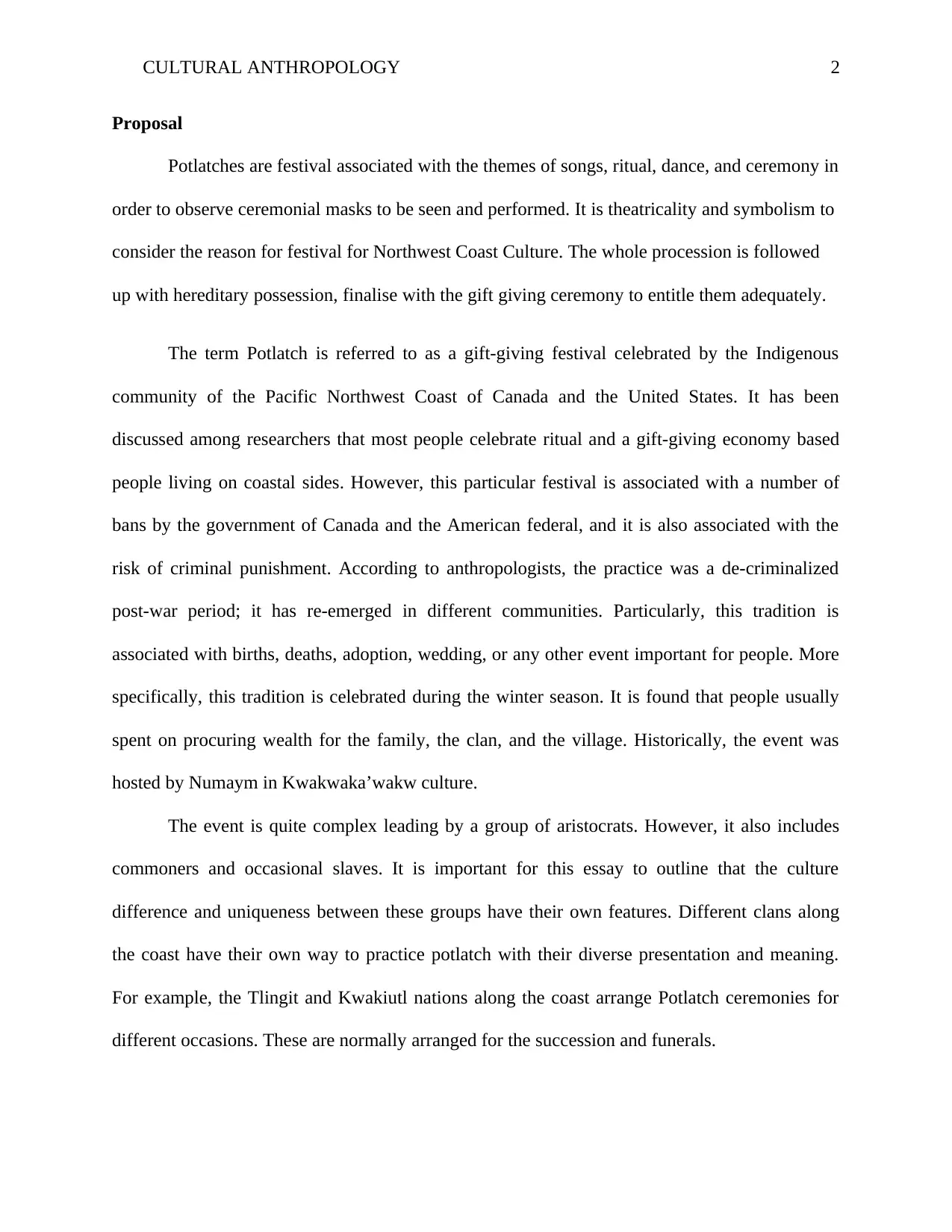
CULTURAL ANTHROPOLOGY 2
Proposal
Potlatches are festival associated with the themes of songs, ritual, dance, and ceremony in
order to observe ceremonial masks to be seen and performed. It is theatricality and symbolism to
consider the reason for festival for Northwest Coast Culture. The whole procession is followed
up with hereditary possession, finalise with the gift giving ceremony to entitle them adequately.
The term Potlatch is referred to as a gift-giving festival celebrated by the Indigenous
community of the Pacific Northwest Coast of Canada and the United States. It has been
discussed among researchers that most people celebrate ritual and a gift-giving economy based
people living on coastal sides. However, this particular festival is associated with a number of
bans by the government of Canada and the American federal, and it is also associated with the
risk of criminal punishment. According to anthropologists, the practice was a de-criminalized
post-war period; it has re-emerged in different communities. Particularly, this tradition is
associated with births, deaths, adoption, wedding, or any other event important for people. More
specifically, this tradition is celebrated during the winter season. It is found that people usually
spent on procuring wealth for the family, the clan, and the village. Historically, the event was
hosted by Numaym in Kwakwaka’wakw culture.
The event is quite complex leading by a group of aristocrats. However, it also includes
commoners and occasional slaves. It is important for this essay to outline that the culture
difference and uniqueness between these groups have their own features. Different clans along
the coast have their own way to practice potlatch with their diverse presentation and meaning.
For example, the Tlingit and Kwakiutl nations along the coast arrange Potlatch ceremonies for
different occasions. These are normally arranged for the succession and funerals.
Proposal
Potlatches are festival associated with the themes of songs, ritual, dance, and ceremony in
order to observe ceremonial masks to be seen and performed. It is theatricality and symbolism to
consider the reason for festival for Northwest Coast Culture. The whole procession is followed
up with hereditary possession, finalise with the gift giving ceremony to entitle them adequately.
The term Potlatch is referred to as a gift-giving festival celebrated by the Indigenous
community of the Pacific Northwest Coast of Canada and the United States. It has been
discussed among researchers that most people celebrate ritual and a gift-giving economy based
people living on coastal sides. However, this particular festival is associated with a number of
bans by the government of Canada and the American federal, and it is also associated with the
risk of criminal punishment. According to anthropologists, the practice was a de-criminalized
post-war period; it has re-emerged in different communities. Particularly, this tradition is
associated with births, deaths, adoption, wedding, or any other event important for people. More
specifically, this tradition is celebrated during the winter season. It is found that people usually
spent on procuring wealth for the family, the clan, and the village. Historically, the event was
hosted by Numaym in Kwakwaka’wakw culture.
The event is quite complex leading by a group of aristocrats. However, it also includes
commoners and occasional slaves. It is important for this essay to outline that the culture
difference and uniqueness between these groups have their own features. Different clans along
the coast have their own way to practice potlatch with their diverse presentation and meaning.
For example, the Tlingit and Kwakiutl nations along the coast arrange Potlatch ceremonies for
different occasions. These are normally arranged for the succession and funerals.
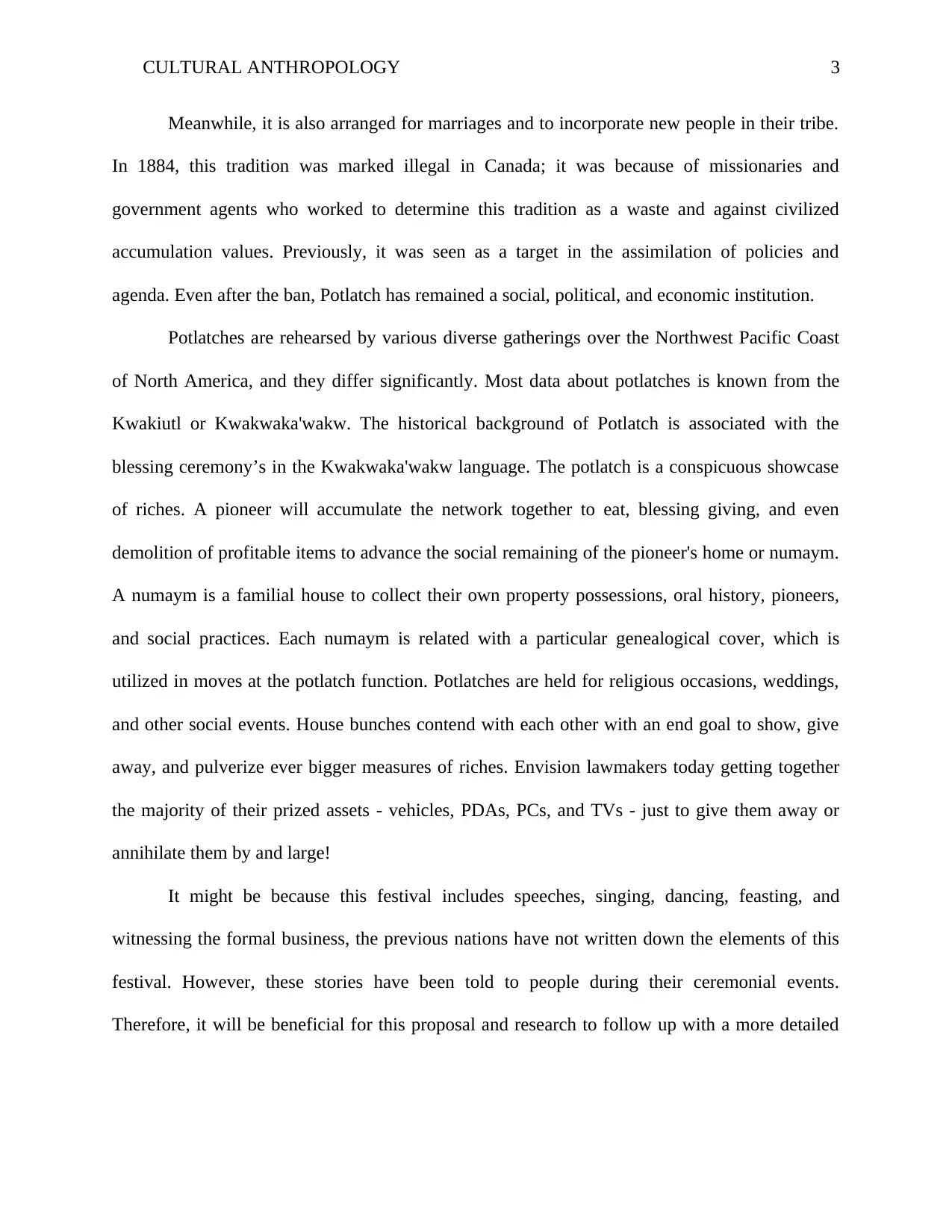
CULTURAL ANTHROPOLOGY 3
Meanwhile, it is also arranged for marriages and to incorporate new people in their tribe.
In 1884, this tradition was marked illegal in Canada; it was because of missionaries and
government agents who worked to determine this tradition as a waste and against civilized
accumulation values. Previously, it was seen as a target in the assimilation of policies and
agenda. Even after the ban, Potlatch has remained a social, political, and economic institution.
Potlatches are rehearsed by various diverse gatherings over the Northwest Pacific Coast
of North America, and they differ significantly. Most data about potlatches is known from the
Kwakiutl or Kwakwaka'wakw. The historical background of Potlatch is associated with the
blessing ceremony’s in the Kwakwaka'wakw language. The potlatch is a conspicuous showcase
of riches. A pioneer will accumulate the network together to eat, blessing giving, and even
demolition of profitable items to advance the social remaining of the pioneer's home or numaym.
A numaym is a familial house to collect their own property possessions, oral history, pioneers,
and social practices. Each numaym is related with a particular genealogical cover, which is
utilized in moves at the potlatch function. Potlatches are held for religious occasions, weddings,
and other social events. House bunches contend with each other with an end goal to show, give
away, and pulverize ever bigger measures of riches. Envision lawmakers today getting together
the majority of their prized assets - vehicles, PDAs, PCs, and TVs - just to give them away or
annihilate them by and large!
It might be because this festival includes speeches, singing, dancing, feasting, and
witnessing the formal business, the previous nations have not written down the elements of this
festival. However, these stories have been told to people during their ceremonial events.
Therefore, it will be beneficial for this proposal and research to follow up with a more detailed
Meanwhile, it is also arranged for marriages and to incorporate new people in their tribe.
In 1884, this tradition was marked illegal in Canada; it was because of missionaries and
government agents who worked to determine this tradition as a waste and against civilized
accumulation values. Previously, it was seen as a target in the assimilation of policies and
agenda. Even after the ban, Potlatch has remained a social, political, and economic institution.
Potlatches are rehearsed by various diverse gatherings over the Northwest Pacific Coast
of North America, and they differ significantly. Most data about potlatches is known from the
Kwakiutl or Kwakwaka'wakw. The historical background of Potlatch is associated with the
blessing ceremony’s in the Kwakwaka'wakw language. The potlatch is a conspicuous showcase
of riches. A pioneer will accumulate the network together to eat, blessing giving, and even
demolition of profitable items to advance the social remaining of the pioneer's home or numaym.
A numaym is a familial house to collect their own property possessions, oral history, pioneers,
and social practices. Each numaym is related with a particular genealogical cover, which is
utilized in moves at the potlatch function. Potlatches are held for religious occasions, weddings,
and other social events. House bunches contend with each other with an end goal to show, give
away, and pulverize ever bigger measures of riches. Envision lawmakers today getting together
the majority of their prized assets - vehicles, PDAs, PCs, and TVs - just to give them away or
annihilate them by and large!
It might be because this festival includes speeches, singing, dancing, feasting, and
witnessing the formal business, the previous nations have not written down the elements of this
festival. However, these stories have been told to people during their ceremonial events.
Therefore, it will be beneficial for this proposal and research to follow up with a more detailed
⊘ This is a preview!⊘
Do you want full access?
Subscribe today to unlock all pages.

Trusted by 1+ million students worldwide

CULTURAL ANTHROPOLOGY 4
study in regards to study and discuss the elements of Potlatch to set a focus and study the factors
that lead to its ban in detail.
study in regards to study and discuss the elements of Potlatch to set a focus and study the factors
that lead to its ban in detail.
Paraphrase This Document
Need a fresh take? Get an instant paraphrase of this document with our AI Paraphraser
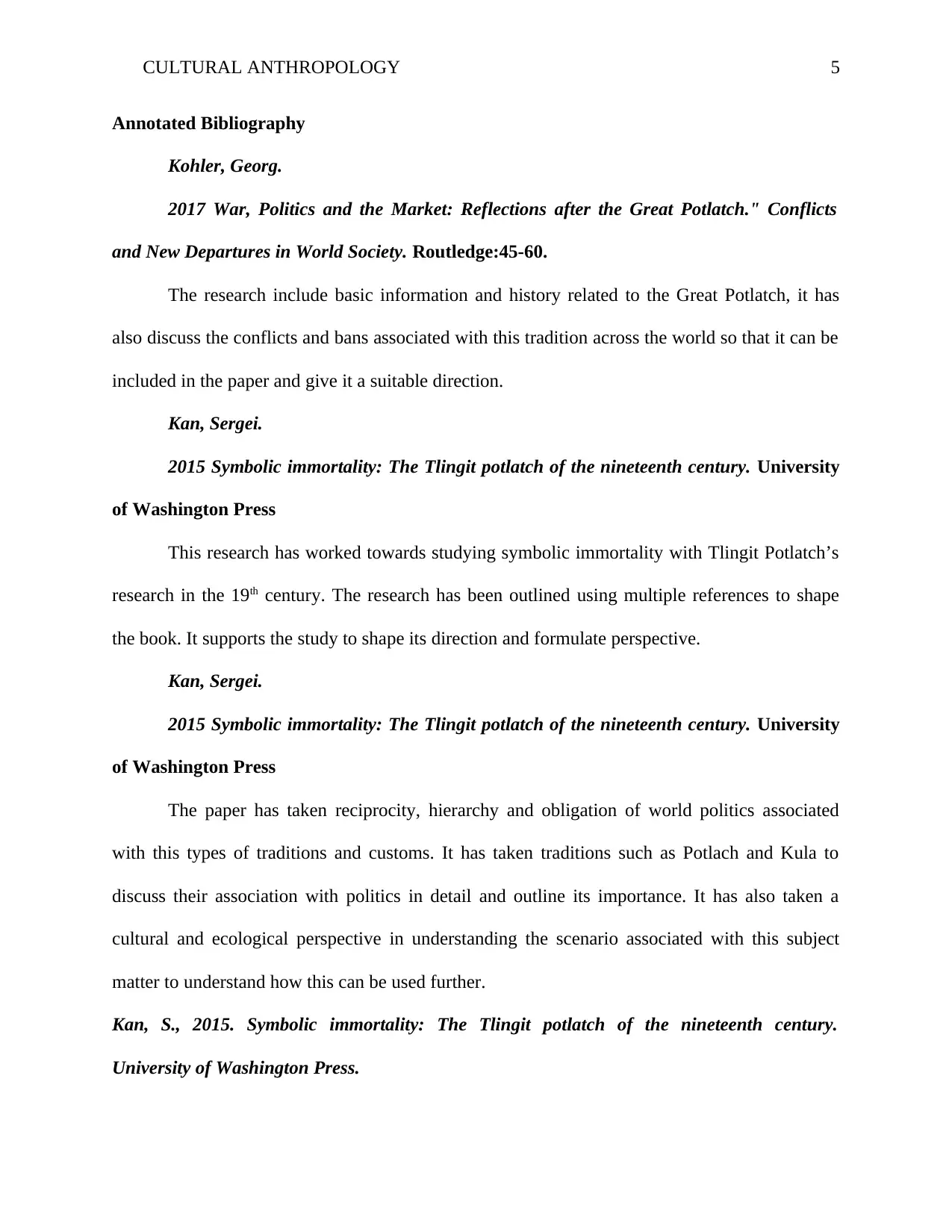
CULTURAL ANTHROPOLOGY 5
Annotated Bibliography
Kohler, Georg.
2017 War, Politics and the Market: Reflections after the Great Potlatch." Conflicts
and New Departures in World Society. Routledge:45-60.
The research include basic information and history related to the Great Potlatch, it has
also discuss the conflicts and bans associated with this tradition across the world so that it can be
included in the paper and give it a suitable direction.
Kan, Sergei.
2015 Symbolic immortality: The Tlingit potlatch of the nineteenth century. University
of Washington Press
This research has worked towards studying symbolic immortality with Tlingit Potlatch’s
research in the 19th century. The research has been outlined using multiple references to shape
the book. It supports the study to shape its direction and formulate perspective.
Kan, Sergei.
2015 Symbolic immortality: The Tlingit potlatch of the nineteenth century. University
of Washington Press
The paper has taken reciprocity, hierarchy and obligation of world politics associated
with this types of traditions and customs. It has taken traditions such as Potlach and Kula to
discuss their association with politics in detail and outline its importance. It has also taken a
cultural and ecological perspective in understanding the scenario associated with this subject
matter to understand how this can be used further.
Kan, S., 2015. Symbolic immortality: The Tlingit potlatch of the nineteenth century.
University of Washington Press.
Annotated Bibliography
Kohler, Georg.
2017 War, Politics and the Market: Reflections after the Great Potlatch." Conflicts
and New Departures in World Society. Routledge:45-60.
The research include basic information and history related to the Great Potlatch, it has
also discuss the conflicts and bans associated with this tradition across the world so that it can be
included in the paper and give it a suitable direction.
Kan, Sergei.
2015 Symbolic immortality: The Tlingit potlatch of the nineteenth century. University
of Washington Press
This research has worked towards studying symbolic immortality with Tlingit Potlatch’s
research in the 19th century. The research has been outlined using multiple references to shape
the book. It supports the study to shape its direction and formulate perspective.
Kan, Sergei.
2015 Symbolic immortality: The Tlingit potlatch of the nineteenth century. University
of Washington Press
The paper has taken reciprocity, hierarchy and obligation of world politics associated
with this types of traditions and customs. It has taken traditions such as Potlach and Kula to
discuss their association with politics in detail and outline its importance. It has also taken a
cultural and ecological perspective in understanding the scenario associated with this subject
matter to understand how this can be used further.
Kan, S., 2015. Symbolic immortality: The Tlingit potlatch of the nineteenth century.
University of Washington Press.
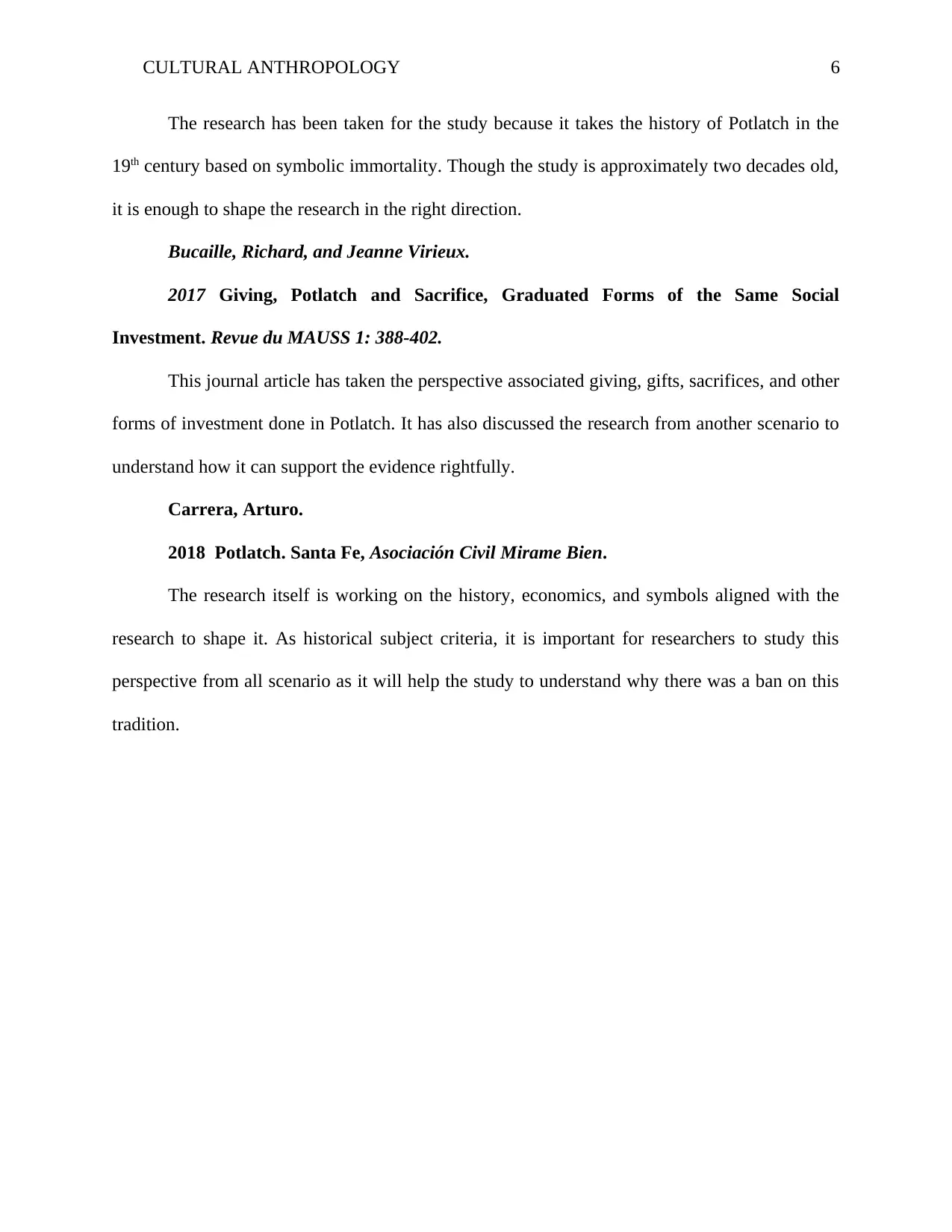
CULTURAL ANTHROPOLOGY 6
The research has been taken for the study because it takes the history of Potlatch in the
19th century based on symbolic immortality. Though the study is approximately two decades old,
it is enough to shape the research in the right direction.
Bucaille, Richard, and Jeanne Virieux.
2017 Giving, Potlatch and Sacrifice, Graduated Forms of the Same Social
Investment. Revue du MAUSS 1: 388-402.
This journal article has taken the perspective associated giving, gifts, sacrifices, and other
forms of investment done in Potlatch. It has also discussed the research from another scenario to
understand how it can support the evidence rightfully.
Carrera, Arturo.
2018 Potlatch. Santa Fe, Asociación Civil Mirame Bien.
The research itself is working on the history, economics, and symbols aligned with the
research to shape it. As historical subject criteria, it is important for researchers to study this
perspective from all scenario as it will help the study to understand why there was a ban on this
tradition.
The research has been taken for the study because it takes the history of Potlatch in the
19th century based on symbolic immortality. Though the study is approximately two decades old,
it is enough to shape the research in the right direction.
Bucaille, Richard, and Jeanne Virieux.
2017 Giving, Potlatch and Sacrifice, Graduated Forms of the Same Social
Investment. Revue du MAUSS 1: 388-402.
This journal article has taken the perspective associated giving, gifts, sacrifices, and other
forms of investment done in Potlatch. It has also discussed the research from another scenario to
understand how it can support the evidence rightfully.
Carrera, Arturo.
2018 Potlatch. Santa Fe, Asociación Civil Mirame Bien.
The research itself is working on the history, economics, and symbols aligned with the
research to shape it. As historical subject criteria, it is important for researchers to study this
perspective from all scenario as it will help the study to understand why there was a ban on this
tradition.
⊘ This is a preview!⊘
Do you want full access?
Subscribe today to unlock all pages.

Trusted by 1+ million students worldwide
1 out of 6
Your All-in-One AI-Powered Toolkit for Academic Success.
+13062052269
info@desklib.com
Available 24*7 on WhatsApp / Email
![[object Object]](/_next/static/media/star-bottom.7253800d.svg)
Unlock your academic potential
Copyright © 2020–2025 A2Z Services. All Rights Reserved. Developed and managed by ZUCOL.
